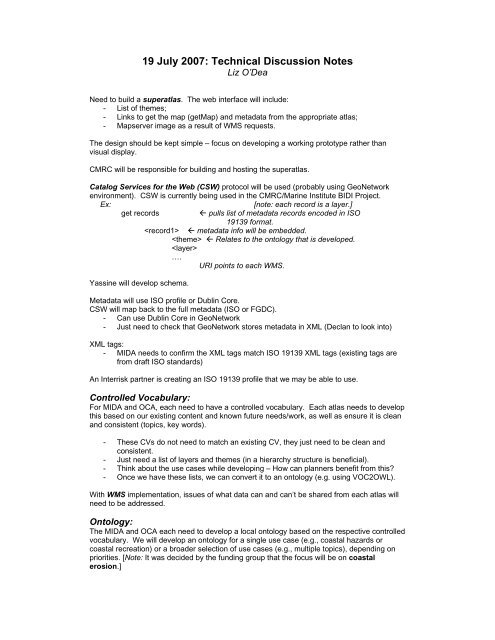19 July 2007: Technical Discussion Notes
19 July 2007: Technical Discussion Notes 19 July 2007: Technical Discussion Notes
- Page 2 and 3: These local atlas ontologies will m
- Page 4 and 5: Slides for Technical Overview for I
These local atlas ontologies will map to the superatlas ontology when that is created. Thefirst conference call about ontologies will be September 12.Web Interface:Luis has an interface already built that we could use for the super atlas.Teleconference Calls:It’s estimated that we will need 2 2-hour conference calls among the technology group todiscuss the development of the global ontology and mapping.- Probably use WebX, which is free teleconferencing software. MMI/Luis will run theapplication and we will call in. CMRC will need to call the MMI teleconference phonenumber to access.- Skype may be an alternative, but it won’t allow viewing of programs running on othercomputers.Communication:Dawn will set up tech group listserv. Need to send her a list of members, and email full list tosee if anyone else wants to join. At the meeting were:- Liz O’Dea- Luis Bermudez- Stephanie Watson- Kuuipo Walsh- Tanya Haddad- Ned Dwyer- Declan Dunne- Yassine Lassoued- Eoin Ó Grady- Dru Clark- Iban Ameztoy- Michelle Kinzel- Greg BenoitOnce the list is created, we need to compile a list of Skype profiles.It was suggested that email communication between individuals be CC’d to the technicalgroup listserv so that people keep informed and can learn about the development.
Task Calendar:**Note: This calendar is based on end of December for the finished prototype.Number Task DeadlineEstimated TimeMIDA OCA MMIT1 Set up <strong>Technical</strong> Group listserv Early August Liz Dawn(Aug)T2 Complete list of themes (topics) andcontrolled vocabulary from MIDA andOCA.End of August 3 days(IA/LOD/YL)3days(TH).5day(LB)T3T4T5Use Case topic/layer list of layerswhich can be shared via WMS(which MIDA and OCA can use tofind a common subset of layers forcomparison)Review existing Coastal HazardsOntologiesDevelop local ontologies for usecasesT6 Make layers available via WMS (5-10or more)T7Teleconferences to create a globaltopics ontology and mapping ( 2 2-hour calls)End of AugustEnd of AugustSeptember 12End ofSeptember1 st : Wed 12Sep. from4-6pm GMT/8-10am PST2 nd : TBD.5 day(IA/LOD)2 days(YL)3 days(YL)1week(LOD/DD)1week(All)T8 Create ISO core schema Mid September .5 day(YL)T9 Implement ISO core schema intoCSWEnd of October 1week(DD/YL)T10 Build web interface of prototype 15 th January 4weeks(DD/YL)T11Prototype Evaluation andImprovementsEarly February 1week(LOD/DD).5day(TH)1 day(TH)3days(TH)1week(TH)1week(TH)2weeks(TH)1week(TH).5day(LB)1day?(LB)1week(LB)1week** Monthly conference calls will be organised for the funding group – the technical group willneed to participate to give updates. Mark the dates listed in the ICAN Timeline athttp://workshop1.science.oregonstate.edu/ican.
Slides for <strong>Technical</strong> Overview for ICAN, given at CZ ‘07Driving Factors for Coastal Web Atlases and their Interoperability• Better planning to cater for increased population pressures in the coastal zone (e.g.the UN estimate that by 2020 75% of the world’s population will be living within 60 mof the coastal zone [UN <strong>19</strong>92; Shi and Singh, 2003]).• Decision support systems in relation to climate change scenarios in vulnerablecoastal regions.• Information to facilitate assessments of risk to natural hazards (including erosion,tsunamis and floods).• Access to data and maps to support Marine Spatial Planning (MSP) / OceanZoning as a tool for better coastal and marine area management.• Maps of jurisdictional boundaries for maritime territories in support of claims related tothe United Nations Convention on the Law of the Sea (UNCLOS), which has adeadline for submissions of 2013.• More efficient and effective coastal and marine area governance, including access torelevant data and information.• Information on resource availability and exploitation including habitat and speciesinformation, as well as ecological and community resilience.Vision: Create a Coastal SuperAtlas Structure• This SuperAtlas Structure will:– Connect multiple coastal web atlases via a distributed network.– Be based on community-held constraints on mapping and presentationconventions, developed to maximize the comparability and reliability ofinformation about our coasts.– Allow integrated searching for data in multiple atlases.– Return data displayed in an integrated web map.– Provide a framework for atlas development initiatives.– Facilitate cross-jurisdictional collaboration, planning and management.– Encourage harmonisation among the global atlas community.• This SuperAtlas structure will not:– Be a global coastal atlas; instead, it will provide a recommended frameworkfor building regional coastal atlas communities.Pilot Study: Developing a Coastal Ontology• What is an ontology?– A data model structure which defines topics within a discipline (e.g., ICZM)and the relationships between those topics.• Why is it important for a SuperAtlas?– Provides a common structure to facilitate interoperability (e.g., sharing data)between atlases.
Global Ontology Fundamental to SuperAtlas StructureUse Case: Coastal Hazards• <strong>2007</strong>-08 pilot study: Focus on Coastal Hazards (e.g., coastal erosion)– Fundamental concern in US and Europe• Tasks:– MIDA and OCA to develop local controlled vocabularies and ontologies.– Create a global ontology based on local ontologies.– Develop prototype web interface to facilitate distributed querying andvisualisation of data from both atlases.– Implement Open Geospatial Consortium services (CSW and WMS).– Prototype Evaluation and Improvements.– Review ways forward for 3rd workshop in <strong>July</strong> 2008.



